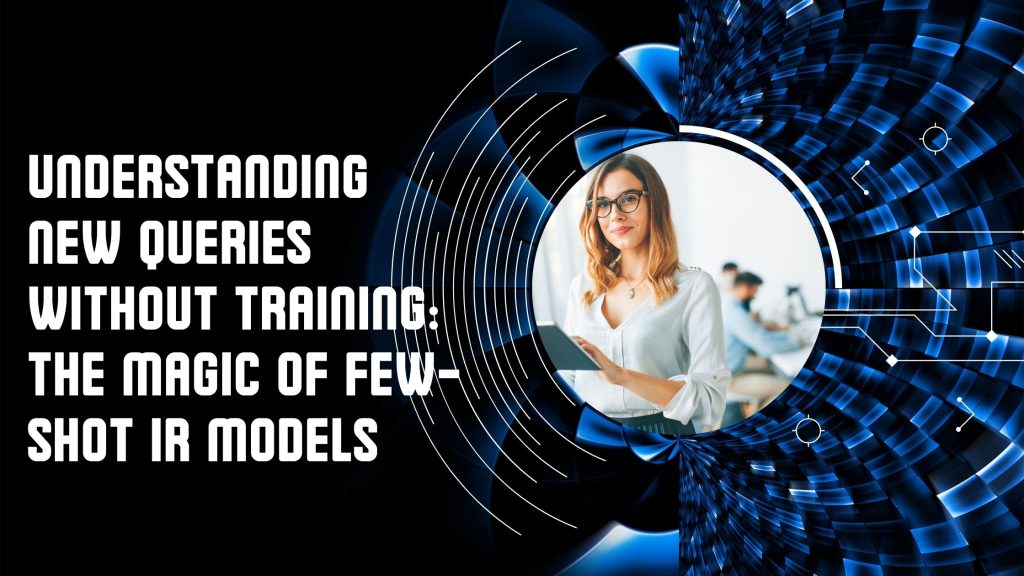The digital age has ushered in an explosion of information. Every day, vast amounts of data are created and shared across the internet. As we sift through this sea of content, one question looms large: how do we efficiently find what we’re looking for? Enter Few-Shot IR Models, a groundbreaking approach reshaping the landscape of information retrieval.
Imagine being able to understand new queries without extensive retraining or massive datasets. This innovative technology leverages minimal examples to deliver relevant results quickly and accurately. The beauty lies in its simplicity and efficiency—no more need for cumbersome procedures that take time and resources.
As we delve deeper into Few-Shot IR Models, we’ll explore their advantages, real-world applications, and what the future holds for this transformative technology. Get ready to uncover the magic behind these models that could revolutionize the way we access information!
The Advantages of Few-Shot IR Models
Few-Shot IR Models offer several distinct advantages that make them appealing in today’s data-driven landscape. They excel in situations where labeled training data is scarce or expensive to obtain. This ability allows organizations to leverage existing knowledge without extensive resources.
Another key benefit lies in their adaptability. Few-Shot models can quickly adjust to new queries, learning from minimal examples. This flexibility enhances user experience by delivering relevant results efficiently.
Moreover, these models require significantly less computational power compared to traditional techniques. As a result, they can be deployed swiftly and effectively on various platforms.
Businesses also appreciate the reduced time-to-market for implementing information retrieval solutions. With Few-Shot IR Models, innovations come faster and more cost-effectively than ever before.
Examples of Successful Few-Shot IR Models
One notable example of a successful Few-Shot IR Model is Google’s T5 (Text-to-Text Transfer Transformer). This model has demonstrated impressive capabilities in various information retrieval tasks by leveraging few-shot learning techniques. It can adapt to new queries with minimal examples, showcasing versatility across diverse datasets.
Another standout is Open AI‘s GPT series. These models excel at understanding context and generating relevant responses based on limited input data. Their ability to infer meaning from sparse examples makes them powerful tools for applications ranging from chatbots to content generation.
Facebook’s DINO represents innovation in self-supervised learning within Few-Shot IR frameworks. By utilizing contrastive learning methods, it learns rich representations that enable effective retrieval with only a handful of labeled instances.
These models illustrate the potential of Few-Shot IR approaches in transforming how we interact with vast amounts of information, making systems smarter and more user-friendly.
How Do Few-Shot IR Models Work?
Few-shot IR models operate on the principle of learning from minimal data. They leverage a small number of examples to understand user queries and deliver relevant results.
These models utilize advanced techniques like transfer learning and meta-learning. By training on diverse datasets, they can generalize knowledge to new tasks with little input. This is akin to recognizing patterns without needing extensive retraining.
When faced with a new query, few-shot IR models analyze similarities between it and previously encountered cases. They identify key features that connect these queries, allowing for accurate information retrieval despite limited context.
The efficiency of these models lies in their ability to adapt quickly. They reduce reliance on vast labeled datasets while maintaining rapid response times, which make them suitable for dynamic environments where user intent constantly evolves.
Limitations and Challenges of Few-Shot IR Models
While Few-Shot IR Models bring innovative approaches to information retrieval, they are not without their limitations. One major challenge is the reliance on high-quality examples for training. If these examples are biased or insufficiently diverse, the model’s performance can suffer significantly.
Another issue lies in understanding context and nuance. Few-shot models may struggle with queries that require deeper comprehension of language subtleties. This often leads to inaccurate results when faced with complex or ambiguous requests.
Additionally, scalability remains a concern. As datasets grow larger and more varied, maintaining accuracy across numerous domains proves difficult for few-shot models. This can hinder their effectiveness in real-world applications where information is constantly evolving.
Interpretability poses challenges as well. Users may find it hard to trust decisions made by these models if they cannot understand how conclusions were drawn from limited data points.
Applications of Few-Shot IR Models in Real-World Scenarios
Few-Shot IR Models are transforming how we interact with information across various domains. In e-commerce, these models enhance product search by understanding user intent from just a few examples, improving the relevance of search results.
Healthcare is another field benefiting significantly. Few-shot learning assists in diagnosing rare diseases by enabling systems to interpret limited patient data effectively. This capability can lead to faster and more accurate medical decisions.
In customer support, chatbots powered by Few-Shot IR Models can adapt to new queries without extensive retraining. They respond intelligently based on previous interactions, providing users with timely assistance while reducing operational costs.
Moreover, in content recommendation systems, these models analyze minimal user history to offer personalized suggestions that resonate well with individual preferences. The versatility of Few-Shot IR Models opens doors for innovation across industries where data may be scarce or rapidly changing.
Future Developments and Potential Impact of Few-Shot IR Models
The future of Few-Shot IR Models is brimming with potential. As technology evolves, these models are expected to become increasingly sophisticated. Researchers are focusing on enhancing their ability to generalize from minimal data.
One exciting avenue involves integrating multi-modal inputs. Imagine combining text, images, and audio for more dynamic information retrieval experiences. This could revolutionize user interactions across various platforms.
Another promising development lies in the realm of personalization. By leveraging Few-Shot IR Models, search engines can tailor results based on individual user preferences without extensive data collection efforts.
Furthermore, advancements in transfer learning might enable these models to adapt quickly across different domains. This adaptability could lead to improved performance even in niche areas where traditional methods struggle.
As industries recognize the value of rapid and efficient information retrieval, we may see a surge in applications ranging from healthcare insights to customer service automation that harnesses the power of Few-Shot IR Models effectively.
Conclusion
Few-Shot IR Model represent a significant leap in the field of information retrieval. Their ability to understand new queries without extensive training opens up exciting possibilities for various applications. From enhancing search engines to improving customer support systems, these models show great promise.
As we continue to explore their capabilities, it’s clear that Few-Shot IR Models can adapt and evolve with minimal input. This flexibility not only streamlines processes but also enhances user experience across platforms.
However, challenges remain in fully harnessing their potential. Ongoing research and development will be crucial as we strive to overcome current limitations.
The future looks bright for Few-Shot IR Model as they pave the way for smarter, more intuitive information retrieval solutions. As technology advances, we can anticipate even more innovative uses that could transform how we interact with data on a daily basis. Embracing this shift will undoubtedly lead us into an era where retrieving relevant information becomes faster and easier than ever before.

